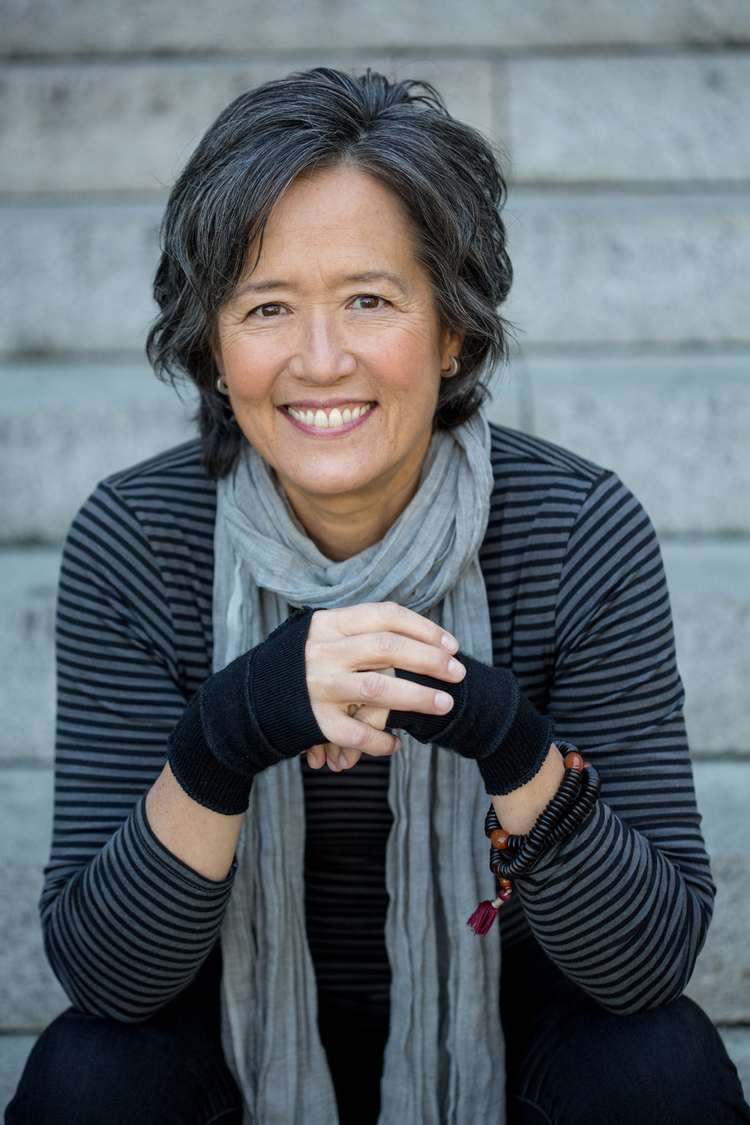Ruth Ozeki on Breaking the Fictional World

“Language, as anyone who writes or reads understands, is fascinating because it’s a technology for time travel,” said Canadian-American author, filmmaker and Zen Buddhist priest Ruth Ozeki on a recent Thursday evening in a dimly-lit cellar screening room in Berlin.
“If you write, you are very conscious of the fact that you’re being like a ventriloquist – you’re projecting your thoughts and words through time into the future.”
In the German city for a literary lounge organized by local book store Dialogue Books, Ozeki alternated between reading passages from her third novel A Tale for the Time Being—which was shortlisted for the 2013 Man Booker Prize and National Book Critics Circle Award—and discussing pervading themes.
“It was December 23, 2006 at 10:52 pm when I started writing the book,” recalled Ozeki with precision. “Because I write on a computer, every time you write in a document there’s a time and date stamp—so you can never forget when you started a project. It’s a little bit discouraging sometimes, especially when it takes you many, many, many, many years to write a project and you’d much rather forget.”
A Tale for the Time Being centres around the weaving of two narratives: a sixteen-year-old suicidal Japanese girl named Nao confiding in her diary about the turmoils of being bullied and unhappy family life, and Ruth, a novelist living on an island off the coast of British Columbia who discovers, and becomes fixated on, a diary hidden within the covers of Marcel Proust’s À la recherche du temps perdu (In Search of Lost Time).
The nature of time is a centrepiece of the novel, as suggested by its title and Nao’s first diary entry, which Ozeki read aloud expressively:
“Hi, my name is Nao and I’m a ‘time being’. Do you know what a time being is? Well, if you give me a moment I will tell you. A time being is someone who lives in time—and that means you and me and everyone of us, who is, and was or ever will be...”
The audience seemed to linger on Ozeki’s candid and charismatic speech, especially when she talked about her preoccupation with time and interest in agnotology, and how these influenced the development of the book.
“Even though I physically sat down to write in 2006, I had clearly been thinking about these ideas before that. It was probably at the turn of the millennium when I really started to think about time—as we all did,” she said.
Two years earlier, in 1998, Ozeki’s father passed away and, around the same time, her mother was diagnosed with Alzheimer’s. Both events led the author to deeply contemplate what it meant to be in time.
“Here was one time being who had dropped out of time and another one who was in the process of a very slowly dropping out of time. Alzheimer’s is really interesting that way because, it’s terrible but, she was moving backwards through time—she was forgetting all her recent memories. The only thing she was remembering were her childhood memories.”
Reading the essays by thirteenth-century Zen master Dōgen Zenji also contributed to the movement of time throughout the novel. Especially one titled Uji, which literally means "being time" but is often translated into English as "time being" or "for the time being."
“There was something about the phrase ‘time being’ that stuck in my head,” said Ozeki. “I think it’s because it’s a very unstable phrase. When you think about ‘for the time being’, if you pronounce it in a flat way, it can mean one thing, but depending on where your intonation is, where the accent falls, it can mean different things.”
Another idea that she reflected on while writing the novel was an area of study called agnotology.
“It’s what I like to think about as what isn’t. More accurately, it could be described as the study of ignorance, the holes in historical records and the manufacturing of ignorance,” she said. “I think as a novelist, it’s a really interesting field of study, because that’s one of the things we do—we’re constantly looking for the holes, we’re looking for the things that aren’t and we try to winkle our ways into them.”
For the longest time, Ozeki didn’t know who the finder and reader of Nao’s diary was or what the interlacing second storyline would be. After five years of auditioning several characters for the role, which involved writing various versions of the book, she finally figured it out and was about to submit a draft to her editor when on March 11, 2011, the Tōhoku earthquake and tsunami hit Japan.
“There are catastrophic moments in history that cause a rift in time. Time is suddenly divided,” she said. “I realized at that point that the book I’d written belonged very firmly to the time of pre-earthquake and it was no longer relevant in the post-earthquake world. So I ended up withdrawing the whole manuscript and pretty much giving up on it.”
But Nao’s voice continued to ring in her head, so Ozeki spoke to her husband about how she could respond to it.
“He suggested that I step into the book myself, as a character. His rationale was that the reality of the earthquake and the tsunami were so catastrophic that it broke the fictional world of the book—if that’s the case, then I have to just allow that break to happen.”
And that’s what she did, by stepping into the novel and creating an autobiographical character named Ruth. Once this happened, Ozeki said she finally understood what the book wanted to be and the writing came very quickly.
“It seemed like the only way to acknowledge the events in Japan and make the fictional world big enough to allow the reality to interpenetrate.”





